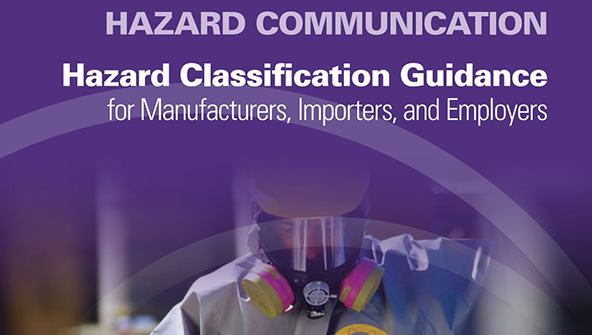OSHA Releases Guide to GHS Chemical Classification, Emphasizes Need for Qualified Professionals
Posted on February 16, 2016 | in Health

OSHA has released a new guide intended to help businesses accurately identify and classify hazards associated with their chemicals, as required by HazCom 2012. The guide—Hazard Classification Guidance for Manufacturers, Importers, and Employers—is available for free on OSHA’s website. It provides review of the classification requirements under GHS, provides expanded definitions and distinctions, and also makes clear the expectation that classification will be undertaken by qualified professionals.
The guide provides a close review of the required process steps for classifying hazards under HazCom 2012, including:
- Identifying the chemical
- Identifying the relevant data regarding the hazards of the chemical
- Reviewing the relevant data to learn the hazards associated
- Determining whether or not the chemical needs to be classified as hazardous based on the definition of “hazardous chemical” in the standard
- Determining the degree of the hazard, where appropriate, by comparing the data with the criteria for health and physical hazards
As most of us know by now, one of the key changes to the Hazard Communication Standard arising from GHS adoption is this concept of severity and the addition of layers and categories to hazard class. No longer are manufacturers just making the determination as to whether or not a chemical is hazardous; now they must also classify the category of severity, or degree of hazard, to better indicate the extent to which a chemical is hazardous.
While manufacturers and importers of chemicals are called upon to identify and classify chemical hazards — and are the primary audience for this guide — it’s clear that this new OSHA document is further meant to be as a resource for end users of chemicals who may wish to “check the work” of upstream entities. As OSHA puts it in the document: “This guidance may also be useful to employers who decide to conduct hazard classifications to assure the accuracy and completeness of information provided to them by suppliers.”
While it does not discuss risk assessments, the new guide seeks to clarify the distinction between “hazard” and “risk.” OSHA says this distinction is “often poorly understood” even by safety professionals. As OSHA makes clear in the text, “hazard” refers to the inherent dangerous properties associated with a substance. While “risk” refers to the probability that a chemical incident will occur under certain conditions. To clarify the distinction, OSHA points out that the hazard of a chemical never changes, but the risk can change drastically based upon the situation into which that chemical is placed.
Finally, and perhaps most importantly, the new guidance document makes clear that the chemical classification process is complex and should be left to trained professionals. OSHA spells out that the guide is not intended to replace a qualified classification expert. To the contrary, the guide articulates OSHA’s expectation that classifications will only be conducted by qualified experts, reading in part:
“The interpretation of information relating to the physical and health hazards associated with a chemical can be a highly technical undertaking, and should be conducted by trained staff such as toxicologists, industrial hygienists, and safety professionals. This document will not replace the need for such professional expertise. It is intended to serve only as useful guidance on the basic considerations and operational aspects involved in the conduct of hazard classifications.”
Elsewhere in the new guide, OSHA spells out that: “For many hazard classes, the criteria are semi-quantitative or qualitative and expert judgment is required to interpret the data for classification purposes.” [Our emphasis.]
Elsewhere still, it refers to classification processes requiring: “technical information which needs to be interpreted by highly trained and experienced experts.” [Our emphasis.]
While OSHA repeatedly invokes the need for expertise, the new guide does not give a precise definition of who exactly qualifies as an “expert.” This is where OSHA enters the land of subjectivity. Keeping that in mind, we at VelocityEHS believe that to err on the side of safety, hazard identification and classification should be undertaken by subject matter experts with established skills in —but not limited to— physiology, biology, or chemistry. They should also have experience recognizing statistical significance, incorporating population size implications, and adjusting for study margins of error.
VelocityEHS’ authoring team of trained, certified professionals can identify and classify hazards under GHS, author original MSDSs, update existing MSDSs, translate new or existing MSDSs, and even review your existing inventory of MSDSs to ensure all documents are in compliance with current regional regulations. We employ experienced regulatory chemical experts and utilize robust authoring technology so you’re assured that your MSDSs comply with all local, national and international regulations, including 16-section ANSI, OSHA HazCom2012, WHMIS 2015, EU, CLP, UN GHS and other global formats
As we continue the “final countdown” toward the June 1, 2016 deadline of full GHS adoption, we can probably expect to see more guidance from OSHA along these lines. If the tone of this document is any indicator, OSHA is expecting not just the classification of chemicals hazards under GHS, but a classification by experts. Stay tuned to the EH&S Blog for more news on this topic as soon as it breaks!